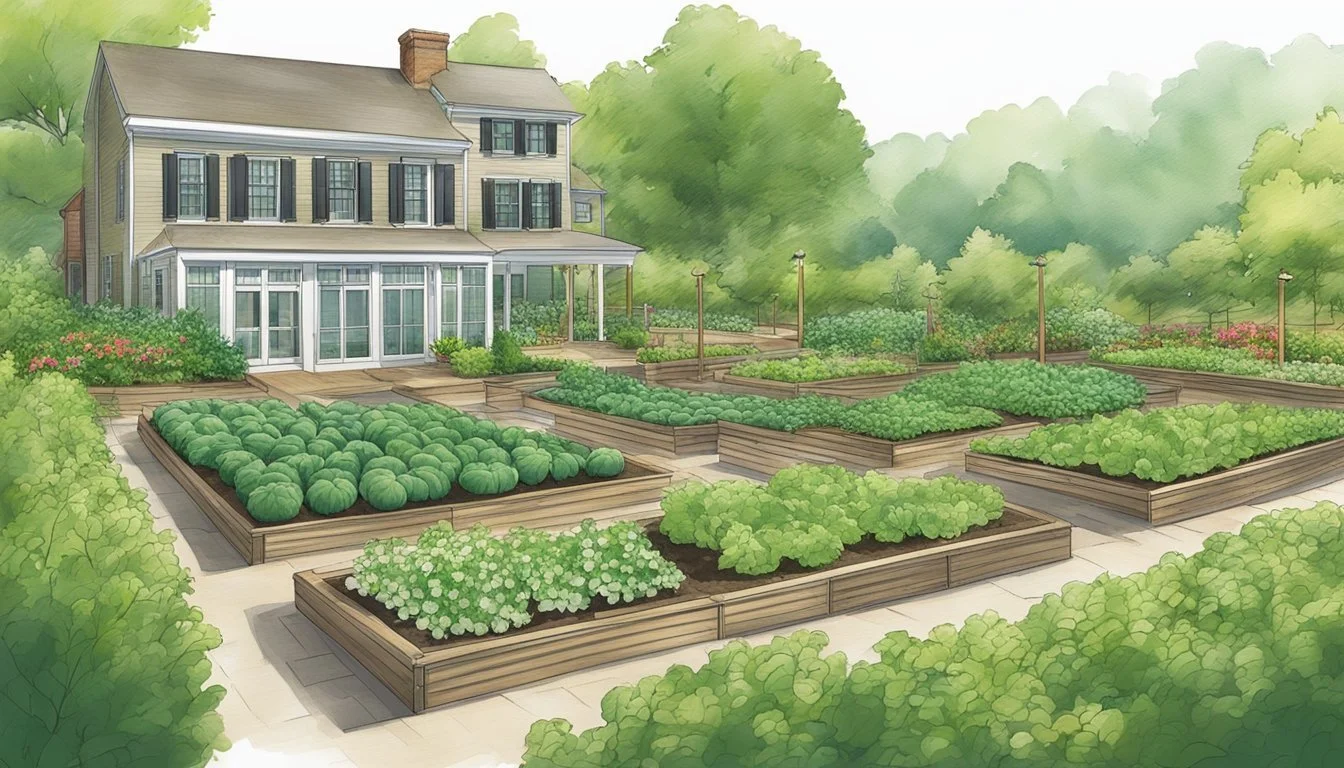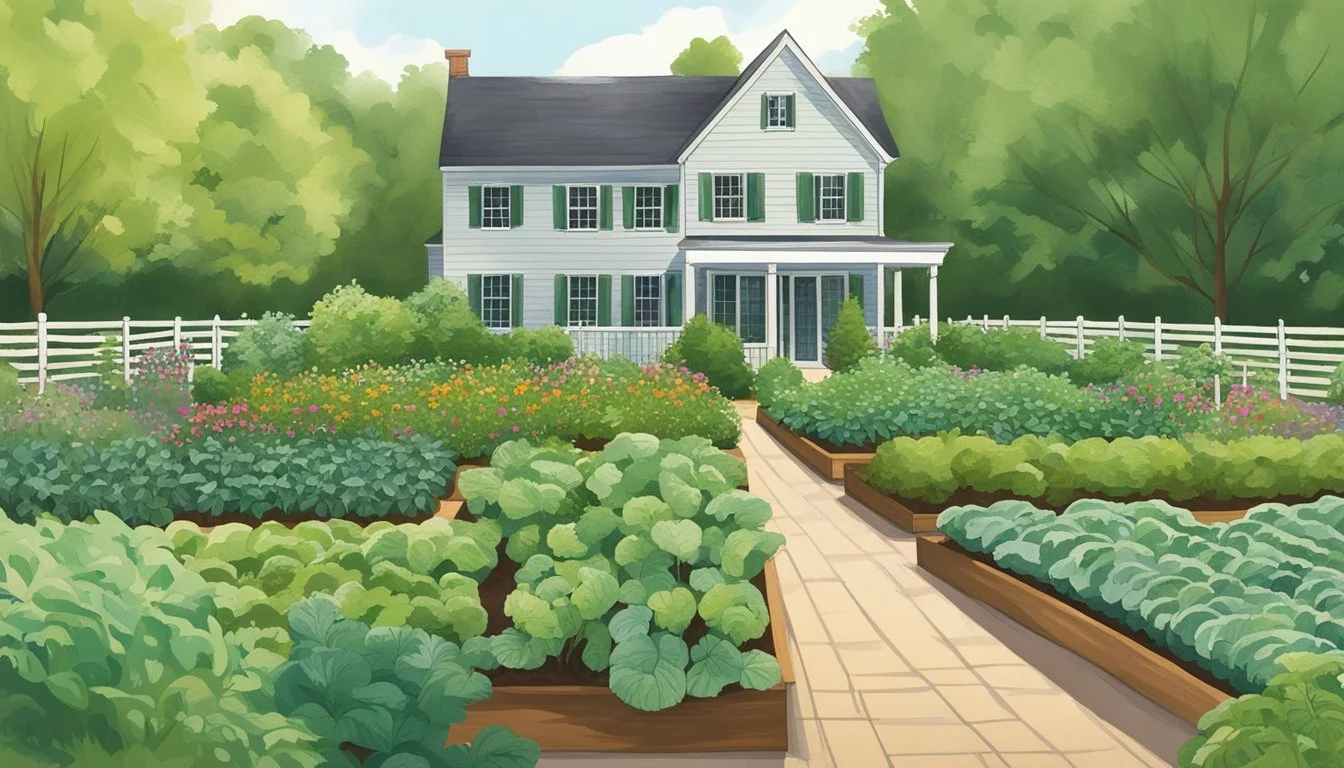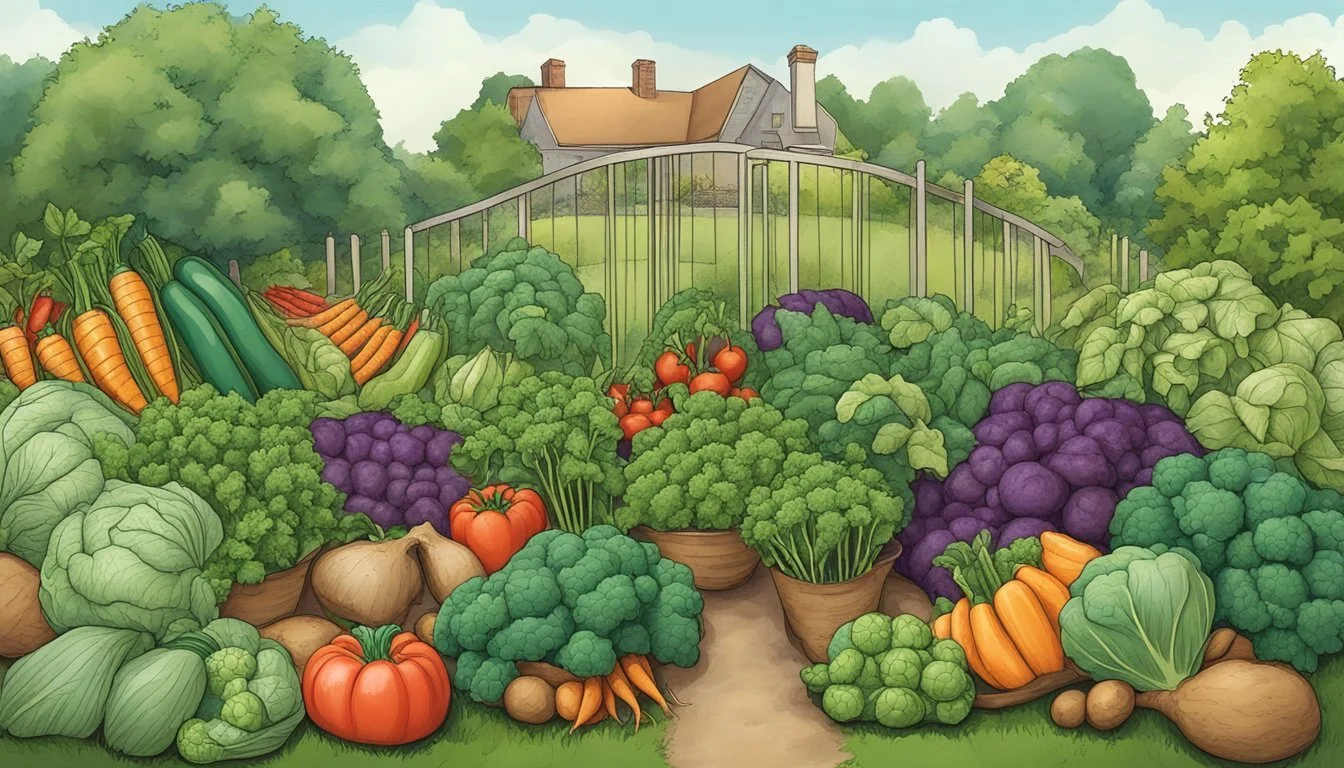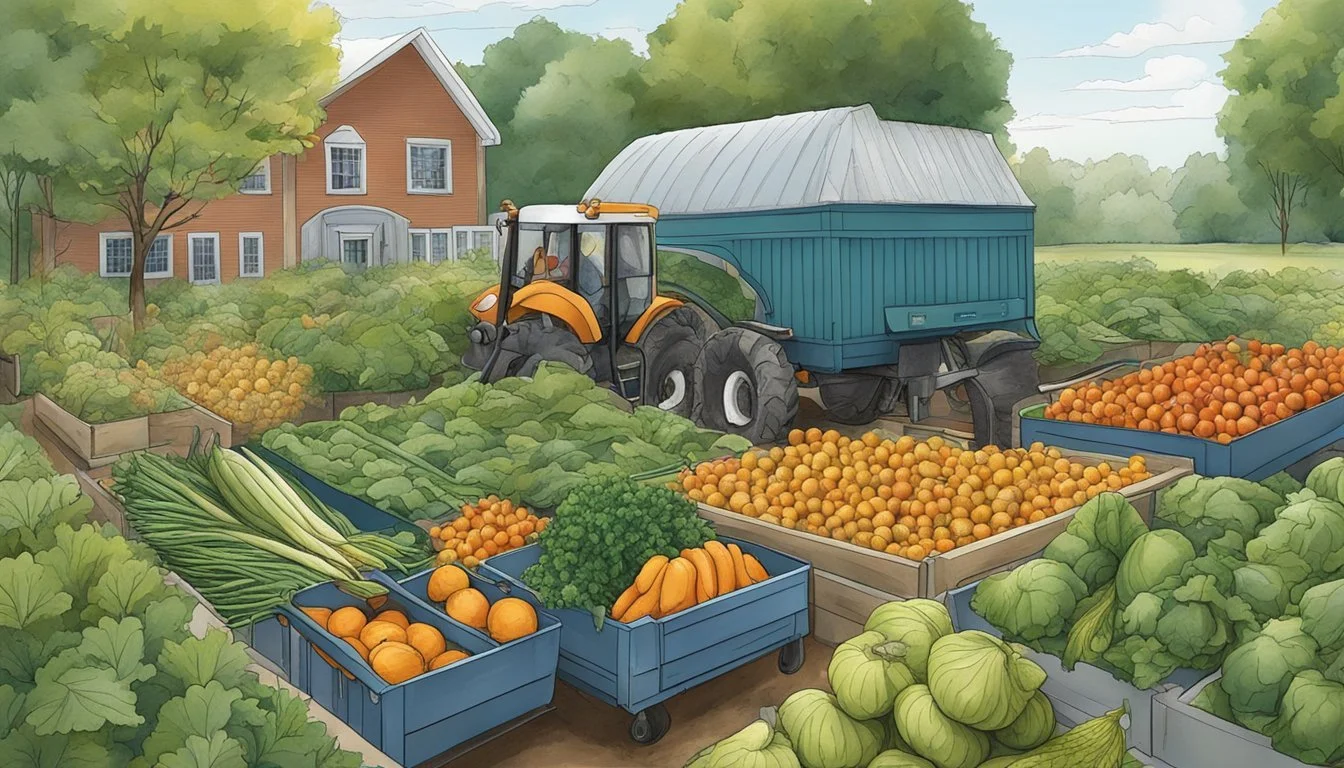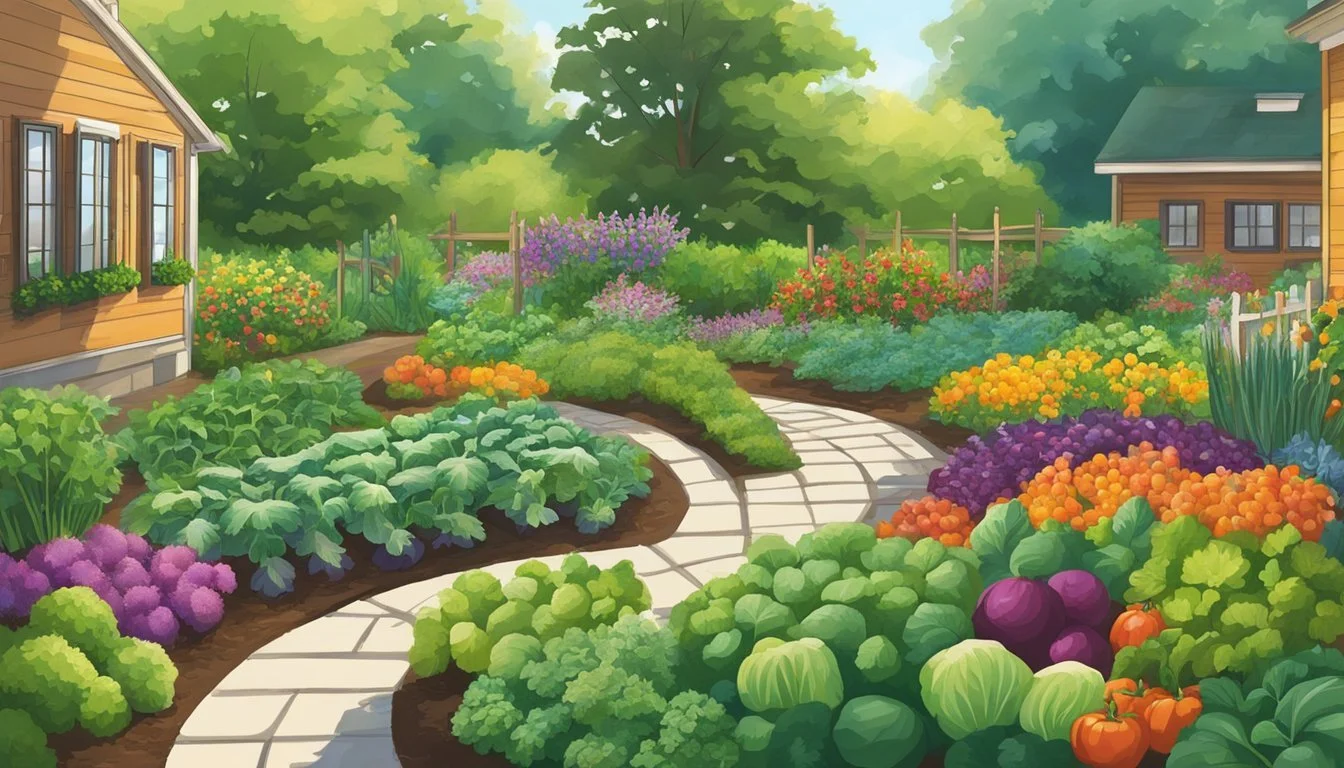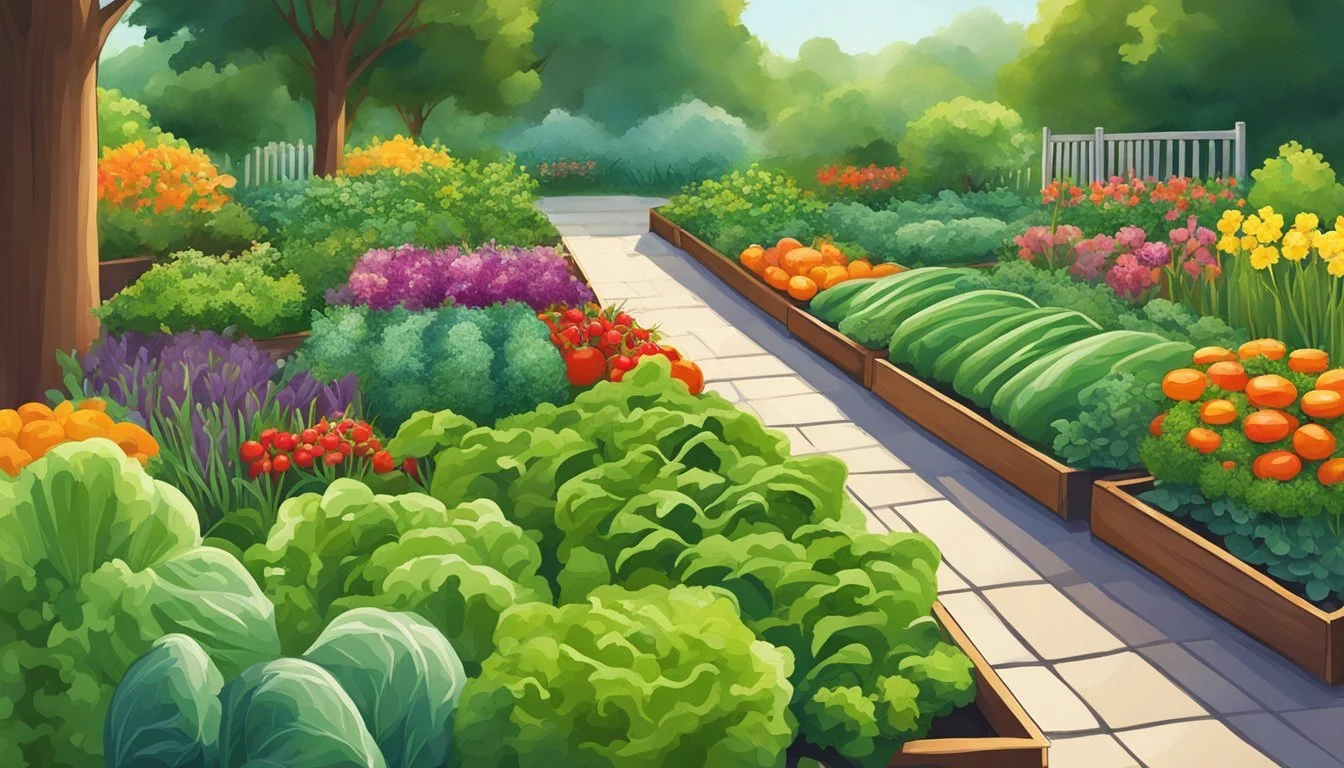Vegetable Gardening in Maryland
A Guide to Growing in the Mid-Atlantic Climate
This Article is Part of Our Guide on Vegetable Gardening by State
Vegetable gardening in Maryland presents a unique opportunity for growers, thanks to the state's moderate climate and extended frost-free growing season. With frost-free days ranging from 150 in the western part to 225 on the Lower Eastern Shore, Maryland offers a suitable environment for a variety of vegetables. Gardeners can take advantage of the state's weather conditions to plan their planting schedules, ensuring a bountiful harvest of both warm and cool-season crops.
Creating a productive vegetable garden in Maryland involves understanding the local soil composition, climate, and choosing the right crops. Some vegetables, such as lettuce, are notably cold hardy and thrive even during Maryland's cooler months, making them an excellent choice for extending the gardening season. The key to success lies in strategic planning, soil preparation, and selecting the planting times that align with Maryland's variable climate patterns.
Incorporating irrigation and weed management techniques is crucial for maintaining a healthy vegetable garden in the region. Options like soaker hoses and drip irrigation systems optimize watering efficiency, which is essential during the hot and humid summer months. Managing weeds is also important; they compete with crops for nutrients and water and may attract pests and diseases. Gardeners in Maryland can achieve success by keeping their vegetable gardens well-maintained throughout the growing season.
Understanding Maryland's Climate
Maryland's climate is predominantly influenced by seasonal changes that affect gardening timing and plant hardiness. Understanding these patterns is crucial for successful vegetable gardening within the state.
Hardiness Zone and Season Planning
Maryland falls within USDA hardiness zones 5b through 8a. This range indicates the plant varieties that can thrive in the state's varying climatic conditions. Gardeners should refer to hardiness zone maps to plan their seasonal gardening activities accordingly. The growing season typically begins in early spring, with last frost dates ranging from early April to late May, depending on the area within Maryland.
Spring: Start cool-season crops.
Summer: Transition to warm-season crops.
Fall: Plant for harvest before first frost.
Winter: Prepare for next year's cycle or grow cold-tolerant crops.
Managing Extreme Heat and Humidity
During Maryland's summers, extreme heat and high humidity can present challenges. Temperatures can rise above 90°F, particularly in July and August. This necessitates close attention to watering practices and mulching to maintain soil moisture and cool the root zones of plants. Gardeners should be aware of the signs of heat stress in plants, such as wilting and leaf scorch, and take preventative actions like:
Providing shade during the hottest parts of the day through the use of row covers or shade cloth.
Planning irrigation for early mornings or late afternoons to reduce water evaporation.
Additionally, increased humidity can lead to fungal diseases, so gardeners should ensure good air circulation around plants and employ disease-resistant plant varieties when possible.
Soil Preparation and Maintenance
Preparation and ongoing care of soil are fundamental for a successful vegetable garden in Maryland. Starting with a soil test and amending the soil sets the stage for a productive growing season.
Soil Testing and Amendment
One should begin with a soil test to understand the current condition of the garden's soil. This will provide critical information about pH levels and the presence of key nutrients. Ideal soil pH for vegetable gardens usually ranges between 6.0 and 7.0. Soil amendments are then made based on the test results.
If soil is too acidic (low pH): add lime to raise pH
If soil is too alkaline (high pH): incorporate sulfur or aluminum sulfate to lower pH
For nutrient deficiencies: apply appropriate fertilizers
Clay soils benefit from the addition of organic matter to improve drainage and aeration, while sand soils require it to increase water and nutrient retention.
Mulching and Composting
Mulching and composting are critical practices for maintaining soil health.
Mulch should be applied to the soil surface to:
Conserve moisture
Regulate soil temperature
Suppress weeds
Compost provides a host of benefits when added to the vegetable garden:
Enhances the soil with organic matter
Improves soil structure
Encourages beneficial microbial activity
For best results, regularly incorporate compost into the garden at the start and end of each growing season.
Selecting Vegetables for Maryland Gardens
In Maryland, gardeners can exploit the state's climate to grow a variety of vegetables. The key to successful cultivation is choosing the right vegetables for the right season, focusing on cool-season and warm-season varieties.
Cool-Season Crops
Maryland's climate accommodates a range of cool-season crops that thrive in the cooler months of spring and fall. These vegetables can often withstand frost and prefer colder temperatures.
Lettuce: includes varieties like Butterhead and Boston; they are hardy and can even handle frost and light snow.
Spinach and Kale: are resilient leafy greens that grow well in cool temperatures.
Radishes and Carrots: mature quickly and prefer the cooler start of the growing season.
Peas: and Broccoli: are also suited for planting in early spring and can handle the chill.
Cauliflower, Brussels Sprouts (how long do brussels sprouts last?), and Cabbage: These cruciferous vegetables do well in cooler weather and can be started early in the season.
Warm-Season Vegetables
When the frost has passed, it's time for warm-season vegetables that need more heat and direct sunlight to prosper.
Tomatoes and Peppers: require warmer soil and night temperatures.
Squash, Cucumbers, and Zucchini: thrive in the heat and need space to spread.
Eggplant and Okra: love the heat and should be planted when the soil is warm.
Corn: It requires a warm environment and benefits from being planted in blocks for better pollination.
Beans: Including Green Beans, they enjoy warm soil and should be sown after the last frost date.
Potatoes and Sweet Potatoes: Plant these tubers when the threat of frost is gone.
Each vegetable has its optimal sowing time, spacing, and care. Maryland gardeners should consult local planting guides for specific instructions tailored to their region.
Garden Design and Organization
In Maryland, maximizing space and ensuring proper soil quality are pivotal for successful vegetable gardening. Raised beds and containers offer flexibility, while vertical gardening maximizes space.
Raised Beds and Containers
Raised beds and portable containers provide distinct advantages for Maryland gardeners. The elevated soil level in raised beds improves drainage and averts soil compaction, facilitating better root growth for vegetables. Common raised bed materials include wood, bricks, and concrete blocks. For the soil, a mix high in organic matter fosters a nutrient-rich environment for vegetables to thrive. Containers, such as the Salad Table™ or Salad Box™ mentioned in Maryland Extension resources, offer portability and allow for gardening in limited spaces like patios or balconies. They require proper soil selection and drainage holes to prevent waterlogging.
Key considerations for raised beds and containers:
Ensure a minimum soil depth of 6-12 inches for adequate root development.
Use high-quality potting mix to promote healthy plant growth.
Vertical Gardening and Space Utilization
Vertical gardening introduces another dimension to crop cultivation, essential for those with small gardens or limited ground space. Utilizing structures like trellises, gardeners can guide the growth of climbing vegetables like cucumbers, pole beans, and tomatoes upwards. This method not only saves space but can also reduce the occurrence of plant diseases by improving air circulation around the plants. In Maryland's varied climate, vertical gardening can help moderate plant exposure to sunlight and wind.
Tips for vertical gardening:
Implement structures such as stakes, cages, or netting for support.
Choose vegetable varieties known for their climbing abilities.
For both small and larger gardens, organization and efficient use of space are key to creating a bountiful and manageable vegetable garden in Maryland.
Irrigation and Water Management
Proper irrigation and water management are vital for a successful vegetable garden in Maryland. It's crucial to implement efficient techniques and understand the regional weather patterns to optimize water usage.
Efficient Watering Techniques
Drip Irrigation: This method is a highly effective and water-efficient system for Maryland gardens. Drip irrigation delivers water directly to the plant's root zone, minimizing waste and evaporation. It can be used with a timer to automate the watering process, ensuring plants receive a consistent amount of moisture, and it's particularly beneficial during Maryland's hot summers.
Advantages:
Reduces water use by up to 50%.
Limits the spread of foliage diseases.
Minimizes weeding by not watering areas between plants where weeds may grow.
Soaker Hoses: These hoses allow water to seep out slowly along their length and can be laid out through garden rows. They are simpler to install than drip systems and less expensive. Soaker hoses are best used in flat areas and require regular monitoring to prevent over-watering.
Best Practices:
Water deeply to encourage deep root growth.
Morning watering is preferable to reduce evaporation and disease risk.
Mulching helps retain soil moisture and regulates temperature.
Dealing With Maryland's Weather Patterns
Gardeners must tailor their watering strategies to Maryland's distinct seasonal weather patterns. Summers can be hot and dry, necessitating frequent, deep watering. Spring and fall may require less irrigation due to increased rainfall.
Soil Texture and Weather Impact:
Sandy soils require more frequent watering due to quick drainage.
Clay soils hold water longer and can be watered less frequently.
Adjust watering based on rainfall; use rain gauges to monitor precipitation.
By understanding and applying efficient irrigation techniques and adapting to Maryland's weather, gardeners can maintain a thriving vegetable garden with optimized water management. Whether using drip irrigation or soaker hoses, being mindful of the weather and soil conditions will lead to the best watering practices for vegetable gardening.
Vegetable Garden Care Techniques
Effective vegetable garden care in Maryland requires precision in planting, nutrient management, and regular maintenance to ensure a successful harvest. Knowledge of these techniques allows gardeners to maximize growth and yield in their gardens.
Planting and Transplantation
Plant selection is critical in Maryland, where the climate can vary across seasons. Gardeners should start with quality seeds or seedlings that are suitable for the local climate. Sun-loving plants should be placed in areas that receive at least 6 to 8 hours of sunlight, while shade-tolerant vegetables might be better suited for spots with less direct sun exposure.
Planting Tips for Beginners:
Plant seeds at the proper depth according to packaging instructions.
Ensure adequate spacing between plants to prevent overcrowding.
Transplant seedlings carefully to avoid root shock.
Nutrient Management and Fertilization
Adequate fertilization is essential for the health and productivity of the vegetable garden. Knowing when and how much fertilizer to apply can significantly impact plant growth. Gardeners should use a balanced fertilizer that suits the nutrient needs of their plants.
Fertilization Guidelines:
Test soil to determine specific nutrient requirements.
Apply fertilizer according to the growth stage of the plant, more so during peak growth periods.
Utilize slow-release fertilizers to provide a steady supply of nutrients.
By adhering to these foundational care techniques and consistently monitoring plant health, Maryland gardeners can cultivate a flourishing vegetable garden.
Pest and Disease Management
Effective management of pests and diseases in Maryland's vegetable gardens is essential for a healthy and productive harvest. Vigilance and early intervention can prevent minor issues from becoming larger problems.
Common Garden Pests
Peppers and tomatoes often attract pests such as aphids, stinkbugs, and fruit worms. Maryland gardeners should inspect their plants regularly to detect these pests before they cause significant damage.
Aphids: These small insects can be found on the underside of leaves, sucking sap and excreting sticky honeydew.
Control: Use a strong water spray to dislodge aphids or introduce natural predators like ladybugs.
Stinkbugs: Recognizable by their shield-like shape, they pierce plant tissue to feed on sap.
Control: Handpick and dispose of them at the first sign of an infestation.
Fruit Worms: These pests burrow into tomatoes and peppers, spoiling the fruit.
Control: Keep the area weed-free and use pheromone traps to monitor and control the population.
Gardeners must also be vigilant against larger pests such as deer, rabbits, and squirrels that can cause damage to the vegetable garden.
Deer: Can decimate a crop overnight by feeding on plants.
Control: Implement fencing or use repellents.
Rabbits/Squirrels: Known to nibble on young vegetables and can dig up plants.
Control: Use mesh covers or barriers to protect plants.
Disease Prevention and Control
Diseases can quickly spread in the humidity of Maryland's climate, making preventative steps crucial.
Tomatoes: Subject to blights and wilts that can wither plants.
Prevention: Ensure proper spacing for air circulation; use disease-resistant varieties.
Herbs/Fruit: Susceptible to fungal infections.
Prevention: Apply fungicide early in the season or at the first sign of disease.
Slugs and other insects can also spread diseases as they move from plant to plant.
Slugs: Feed on young seedlings and leaves, often at night.
Control: Place traps or sprinkle diatomaceous earth around susceptible plants.
The implementation of Integrated Pest Management (IPM) practices can provide holistic solutions. This includes cultural, biological, and chemical strategies to keep gardens healthy and free of pests and diseases.
Harvesting and Storage
Proper harvesting and storage practices are crucial for maintaining the quality and longevity of vegetables grown in Maryland. These practices ensure that gardeners enjoy the rewards of their efforts well beyond the growing season.
Timing and Techniques
When harvesting vegetables, timing is critical. Vegetables should be harvested at their peak maturity when flavor and nutritional content are highest. For many vegetables in Maryland, this timing can vary depending on the weather conditions throughout the growing season. Gardeners should keep a close eye on each crop's development and be ready to harvest promptly.
Cold-Weather Crops such as kale and Brussels sprouts may even benefit from a light frost, which can sweeten their flavor before harvest. The technique used during harvesting is equally important:
Leafy Greens: Harvest in the morning when the leaves are firm and well-hydrated.
Root Vegetables: Lift gently to avoid damage and remove excess soil.
Fruit Vegetables (like tomatoes and peppers): Clip or carefully twist off to prevent plant injury.
For sustained yield, gardeners may implement successive planting and staggered harvesting methods.
Preservation and Usage of Harvest
Once harvested, vegetable preservation is key to extending the usability of the produce. There are various methods for preserving the harvest, each suited to different types of produce:
Refrigeration: Store leafy greens, cruciferous vegetables, and most root vegetables in the refrigerator to maintain freshness.
Canning: Tomatoes and cucumbers are excellent candidates for canning, allowing for enjoyment long after the harvest season.
Drying: Herbs and some vegetables like beans can be dried for long-term storage.
In addition to these methods, gardeners might consume freshly harvested vegetables immediately, capitalizing on the fresh flavors and nutritional benefits. Cold-weather crops often store well in cool, humidity-controlled environments, which can naturally extend their shelf life.
Gardening Resources and Community
In Maryland, gardeners have access to a wealth of resources and a supportive community. Whether one is new to gardening or possesses a seasoned green thumb, local groups and educational materials are readily available to enhance their gardening journey, covering all ages and fostering inclusivity across different races and communities.
Local Gardening Groups
They can find a local community garden through their county or city government, or by visiting the University of Maryland Extension's Locations page. These gardens provide opportunities for residents to learn, share experiences, and cultivate vegetables even if they lack individual space.
Public Housing Residents: Access community gardens through local programs.
Vital Contacts: Engagement with county or city recreation and parks departments is essential.
These spaces not only facilitate communal engagement but also provide access to gardening pots and plots suited for urban settings.
Educational Materials and Guides
The University of Maryland Extension offers a wide array of educational resources that guide gardeners through the process of establishing and maintaining vegetable gardens.
Master Gardener Programs: Offer classes and workshops on various gardening topics.
Online Resources: Include food gardening videos and guides on container gardening and maximizing small spaces.
The educational materials are designed to accommodate gardeners of all proficiency levels, ensuring everyone in the community has the tools they need to succeed in their gardening endeavors.
Additional Tips for a Thriving Vegetable Garden
Creating a bountiful garden requires attention beyond just planting and watering. It's important to consider factors like wildlife management, selecting appropriate crops, and utilizing advanced gardening techniques.
Dealing With Wildlife
To protect a vegetable garden from wildlife in Maryland, gardeners should take proactive measures. Fencing is an effective barrier and should stand at least 8 feet tall to deter deer. Hardware cloth can be used to ward off smaller critters. Additionally, strategic planting of trees and shrubs can provide a natural barrier that makes it harder for wildlife to access the garden.
Cold Hardy and Low-Maintenance Crops
Crops that are both cold hardy and low-maintenance are ideal for Maryland's climate. An excellent example is lettuce, which can flourish in the state's cold springs and falls, and even survive frosts. Other similar vegetables include kale and spinach. These crops require minimal care and don't need the warm soil that more sensitive plants demand.
Advancements in Gardening Techniques
Innovations in gardening can help Maryland gardeners succeed. Drip irrigation systems are a significant advancement, delivering water directly to roots, conserving water, and minimizing disease by keeping foliage dry. Another technique is vertical gardening, which utilizes structures like trellises or towers, saving space and reducing contact with soil-borne diseases. This can be particularly effective near buildings where space is limited.
Choosing the right vegetables and implementing advanced techniques can significantly improve the health and yield of a vegetable garden in Maryland.
Conclusion
Vegetable gardening in Maryland is a practice enriched by the region's diverse climate and soil conditions. Gardeners can anticipate a growing season that varies from 150 days in the western regions to as much as 225 days on the Lower Eastern Shore. The success of a vegetable garden hinges on understanding and adapting to these local conditions.
Achieving a thriving garden involves careful planning and selection of suitable vegetable varieties. Some plants flourish in cooler temperatures, while others require more warmth. Gardeners are advised to consider the distinct needs of each vegetable, spacing them adequately, and ensuring soil and moisture conditions are optimal for growth.
Maryland's gardeners should be prepared to adjust their cultivation practices based on the unique attributes of their specific location. Incorporating the valuable insights gained from agricultural extensions and expert resources will also contribute to a bountiful harvest.
Key Takeaways:
Climate Adaptability: Adjust planting times and choose appropriate varieties for your area.
Soil and Water Management: Ensure the soil is fertile and maintain consistent moisture levels to support plant health.
Careful Planning: Pay attention to the spatial needs of different vegetables to prevent overcrowding.
By embracing these principles, residents can enjoy the benefits of homegrown produce, enhancing both their table and their well-being.
Remember, every plant's success story is rooted in the attention and knowledge a gardener brings to their garden.




